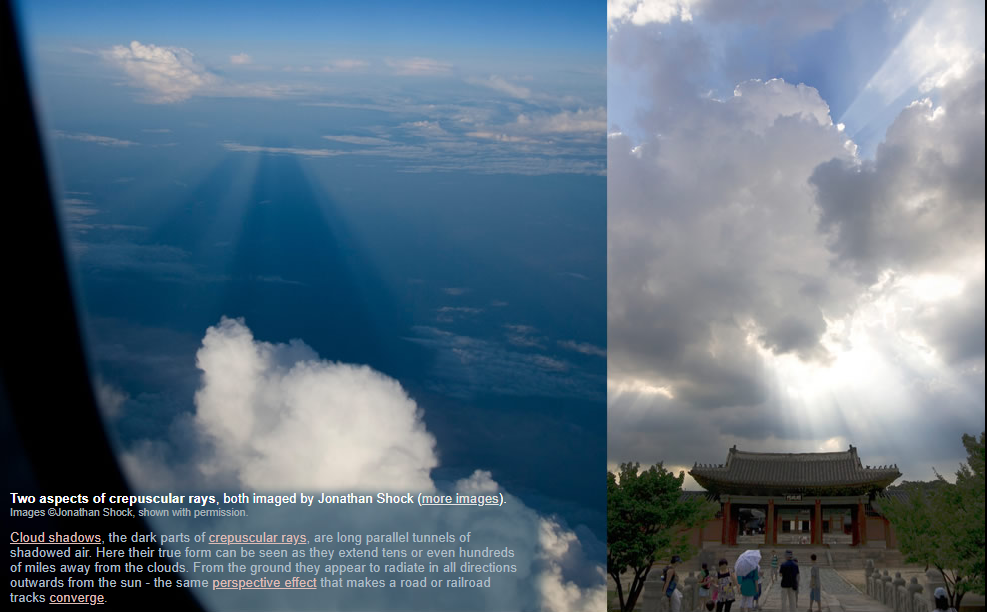Rays ~ Two Views
Rays ~ Two Views: Exploring the Phenomenon of Crepuscular Rays
Crepuscular rays, also known as sunbeams, are a mesmerizing atmospheric optical phenomenon that captivates our imagination. These beautiful rays of sunlight streaming through gaps in clouds or other obstructions create a breathtaking sight. In this article, we will delve deeper into the topic of crepuscular rays and explore two fascinating aspects of this phenomenon.
The Nature of Cloud Shadows
One intriguing aspect of crepuscular rays is the presence of dark areas known as cloud shadows. These shadows manifest as long, parallel tunnels of shadowed air that extend for tens or even hundreds of miles away from the clouds. From the ground, they appear to radiate in all directions outwards from the sun, much like a road or railroad tracks converging into the distance.
The Perspective Effect
The appearance of crepuscular rays radiating from the sun is a result of the perspective effect. Just as parallel lines seem to converge when observed from a distance, the beams of sunlight passing through gaps in clouds create the illusion of rays spreading outwards. This visual phenomenon adds to the allure and mystique of crepuscular rays.
The Role of Atmospheric Particles
To fully understand the formation of crepuscular rays, we must consider the role of atmospheric particles. These particles, such as dust, water droplets, or ice crystals, scatter sunlight in various directions. When sunlight encounters obstructions like clouds, mountains, or buildings, it casts shadows and reveals the paths of these scattered rays, resulting in the awe-inspiring display we observe as crepuscular rays.
The Science Behind Crepuscular Rays
Crepuscular rays are a prime example of how light interacts with the atmosphere to create stunning visual effects. When the sun is partially obscured by an obstruction, such as clouds or mountains, only certain paths of sunlight are able to penetrate through the gaps. These rays of light then interact with the particles in the atmosphere, scattering and creating the dramatic beams we see.
The Influence of Weather Conditions
The formation and visibility of crepuscular rays are influenced by various weather conditions. The presence of moisture in the air, such as high humidity or the presence of clouds, enhances the scattering of light and contributes to the intensity of the rays. Additionally, the angle at which the sunlight interacts with the atmosphere plays a role in the extent and direction of the rays.
The Spectacular Extent of Crepuscular Rays
Crepuscular rays can extend over vast distances, reaching tens or even hundreds of miles away from their source. This remarkable extent highlights the scale and grandeur of these atmospheric phenomena. It is awe-inspiring to contemplate how rays of sunlight can traverse such great distances, casting their ethereal glow upon the Earth's surface.
Capturing the Beauty of Crepuscular Rays
Photographers and enthusiasts alike are drawn to the captivating beauty of crepuscular rays. The interplay of light and shadow, the convergence of parallel lines, and the ethereal quality of these rays make them a favorite subject for photographers seeking to capture the magic of nature. Through their lenses, they immortalize these fleeting moments of atmospheric splendor.
Cultural Significance
Throughout history, crepuscular rays have held cultural significance in various societies. In many ancient civilizations, these rays were often associated with divine intervention or messages from the gods. They have been depicted in art, literature, and mythology, symbolizing spirituality, enlightenment, and the transcendent power of light.
A Reminder of Nature's Marvels
Crepuscular rays serve as a reminder of the wonders and mysteries of our natural world. They remind us of the intricate interplay between light, particles, and atmospheric conditions that create such breathtaking visual displays. These rays beckon us to pause, appreciate, and marvel at the beauty that surrounds us, even in the most ordinary moments.
Conclusion
Crepuscular rays, with their captivating beauty and intriguing characteristics, continue to fascinate and inspire us. Whether we view them as a scientific phenomenon, a photographic subject, or a cultural symbol, they remind us of the intricate and awe-inspiring wonders of our atmosphere. So, the next time you find yourself witnessing these ethereal rays piercing through the clouds, take a moment to appreciate the magic of nature unfolding before your eyes.

Two aspects of crepuscular rays, both imaged by Jonathan Shock (more images). Images ©Jonathan Shock, shown with permission.
Cloud shadows, the dark parts of crepuscular rays, are long parallel tunnels of shadowed air. Here their true form can be seen as they extend tens or even hundreds of miles away from the clouds. From the ground they appear to radiate in all directions outwards from the sun - the same perspective effect that makes a road or railroad tracks converge.
Note: this article has been automatically converted from the old site and may not appear as intended. You can find the original article here.
Reference Atmospheric Optics
If you use any of the definitions, information, or data presented on Atmospheric Optics, please copy the link or reference below to properly credit us as the reference source. Thank you!
-
<a href="https://atoptics.co.uk/blog/rays-two-views/">Rays ~ Two Views</a>
-
"Rays ~ Two Views". Atmospheric Optics. Accessed on November 26, 2024. https://atoptics.co.uk/blog/rays-two-views/.
-
"Rays ~ Two Views". Atmospheric Optics, https://atoptics.co.uk/blog/rays-two-views/. Accessed 26 November, 2024
-
Rays ~ Two Views. Atmospheric Optics. Retrieved from https://atoptics.co.uk/blog/rays-two-views/.